Lara Weiss and her team write a digging diary every week (see below photos)
Excavations in Saqqara 2019
15 March 2019 a research team from the National Museum of Antiquities arrived in Egypt, near the village of Saqqara. That is the excavation site where they do six weeks of research every year into an ancient Egyptian burial ground. This year the team is going to dig a piece of land under which perhaps a grave is located. Just like last year, the Milanese 3D Survey Group will perform a number of underground scans. A stone conservator and a specialist for research of human remains were also brought along. Together with the project partners of the Turin Museo Egizio, we hope for beautiful and interesting finds this year.
Partner Museo Egizio
The team consists of several scientists and is led by Dr. Lara Weiss, curator of the Egyptian collection of the National Museum of Antiquities and Dr. Christian Greco, director of the Museo Egizio, Turin. The project is co-funded by the Netherlands Organisation for Scientific Research.
- Read more about the backgound and history of the excavation project in Saqqara.
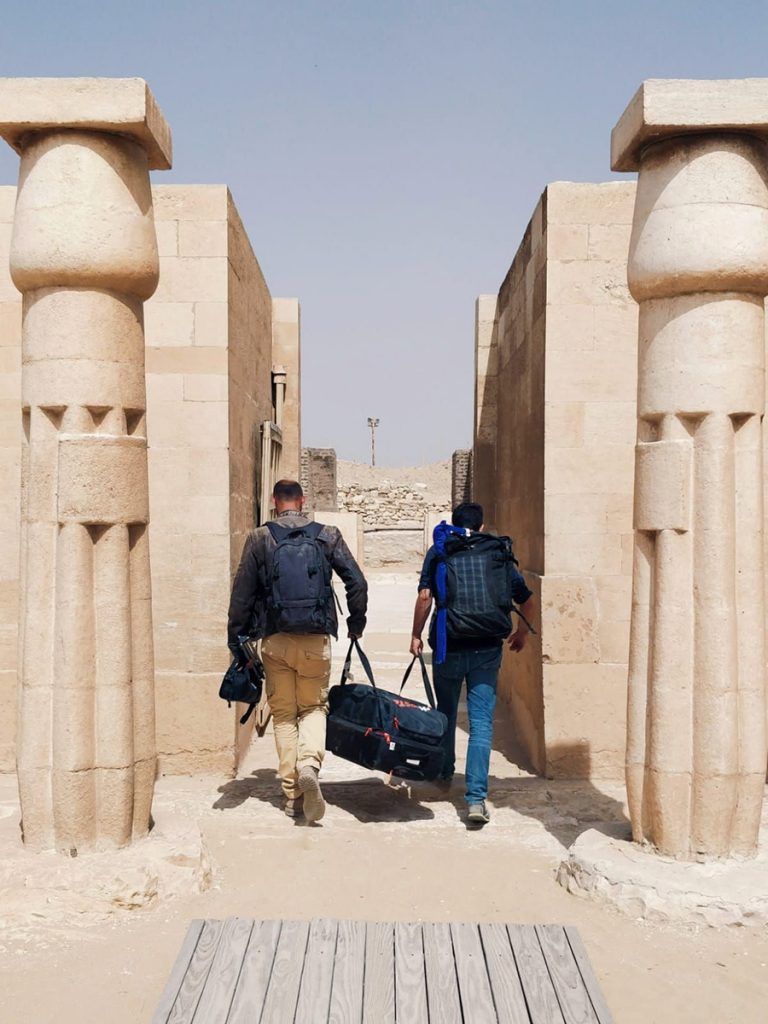
Week 6: team members Daniel Soliman and Nicola Dell'Aquila leave the excavation site.
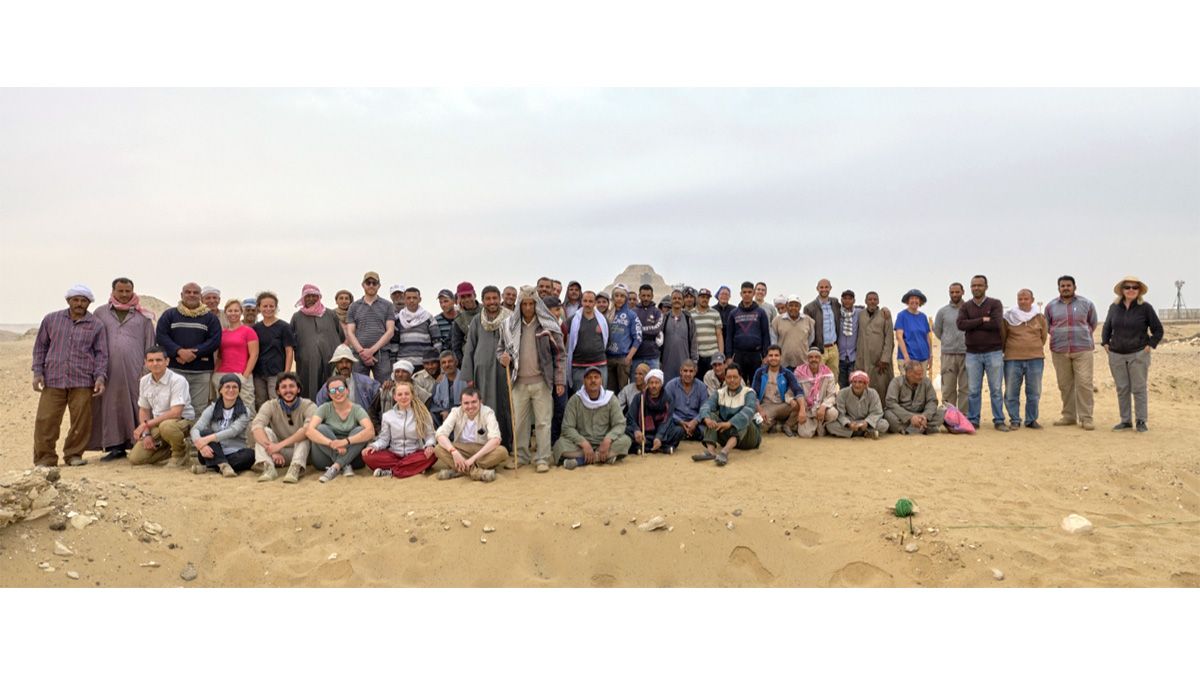
Week 6: team photo of all researchers and local staff in the 2019 excavation season.
Digging diary
Week 6 (19-26 April 2019)
Diary
by Paolo Del Vesco, Daniel Soliman and Lara Weiss:
Time flies when you’re having fun, and here we find ourselves at the end of the excavation season! Our last day of work was on Tuesday, while we spent Wednesday closing the site and ensuring that all objects are securely placed in the storerooms. All in all it was a shorter, but still rather hectic week. As usual, at the end of the season we wrap up everything, clean all of the excavation area for the final general photos and survey, process the last pottery and bone fragments, and document the last finds. In addition, and very importantly, we had to remove the huge dump of excavated sand we produced during these six weeks of work, to clear the area for future excavations. We also backfilled all the structures we unearthed in order to preserve everything in the best possible way for seasons to come.
Before doing that, however, we had three more days to continue with the excavation, and we didn’t want to waste a single minute. Therefore, Paolo decided to split our team of workmen in two groups. This allowed us to work simultaneously on the still rather high mound of debris overlooking the structures discovered in the past two years, as well as inside the large tomb found last year and further explored in the present season. We now know the total extension of the tomb and can tell that unfortunately it was heavily plundered, most likely in the 19th century. We found the remains of three columns of the central courtyard, and we could determine that the floor of the main entrance is neatly paved with nice limestone slabs. We managed to better understand the relationship of this tomb with the surrounding area, but the excavation of its main funerary shaft and the exploration of its underground chambers must wait till next year. See you in a year, then, very interesting tomb!
You might not expect it from the excavation of a dump, but the work brought to light various objects that demanded all of our attention. We found copious amounts of fragments from wood coffins, some with their original paint preserved. But the sands also revealed other material that was used for burials. There were many fragments of linen textile that may have accompanied buried individuals from the Late Antique period. Egyptian linen is famous for its extraordinary quality, and we experienced this first hand as many fragments from shawls, hats and tunics were large and well preserved. This experience serves us very well, because the curators of the National Museum of Antiquities in Leiden are preparing an exhibition on Egyptian textiles that will be opened in 2020.
One category of objects that has occupied us this season fragments of a type of coffin that Egyptologists funnily enough call “slipper coffins”. These are anthropoid ceramic coffins, usually of Nile silt, that completely enveloped the mummified body. The fragments that we discovered date to the Late Period and are often rather crudely modeled. On occasion, however, we documented fragments with nice decoration and traces of paint.
Meanwhile, on the site, we are regaled by the stories of our Egyptian team members. The older ones among them have been working at Saqqara excavations for many years, and they remember the many discoveries made. During an idle moment while reorganising our storerooms in the subterranean chambers of the tomb of Meryneith, Assam Azmi told us about the famous moment when he discovered the statue of Meryneith together with Maarten Raven and René van Walsem. The statue has since found a new home in the Egyptian Museum in Cairo.
The team has now packed up and said their goodbyes to our wonderful staff who took good care of us at the dig house. After a long day’s work in the sun, we used to come home to Atef, Mahmoud and Fahim who welcomed us with a cold glass of home-made lemonade. Together with them we have celebrated the birthdays of some of the team members, and we were happy to return the favour by cooking gnocchi for Atef’s birthday. The team members, tired but content with the work, are now on their way home, where the results of this season will be processed further. We look forward to telling you more soon, first at this year’s Saqqara Day on 15 June 2019!
Digging diary
Week 5 (12 – 19 April 2019)
Diary: How to protect the dead at Saqqara
by Ali Jelene Scheers:
Hi everyone, Ali Jelene checking in for week 5. As with the previous two seasons, I’m responsible for the human remains at our site.. From excavation to storage and everything in between! As we haven’t found any new burials yet, I’ve had some time to focus on other aspects of dealing with human remains from an archaeological context. You see, archaeology doesn’t stop once a burial (or an item, a find, an object…) is excavated. The act of excavating disturbs the materials that have been in a certain place for ages, and this shift in environment is often enough to disrupt the careful equilibrium that preserved the material in the state we excavate it in. In order to avoid further decay, we have to undertake adequate steps in the handling and storage of the materials we find. This sounds complicated, but if you know the materials you’re working with and what they require in terms of storage, it should be pretty straightforward.
In regards to human remains specifically, there is of course the ethical aspect. We are dealing with the remains of actual human beings, and while we don’t know any of their direct descendants currently alive today, we should still treat these remains with respect from the moment we excavated them all the way until we place them in the storage room.
This brings us to the topic of this week’s digging diary: storage. Once human remains have been analysed, they should be stored in a way that meets several goals. We want to treat them the way we ourselves would want to be treated, we don’t want them to decay further, all the while making sure that we keep them available for future research. Who knows what interesting new techniques might be discovered in the future, allowing us a better insight in the lives of ancient Egyptians. It is with this in mind that I’ve been spending the season optimising the storage situation on site. Let me give you a look into the process of how we’re currently doing it.
Once the analysis of a burial is finished, we first label every single bone by applying a thin layer of clear nail polish before writing the unique burial number on it. This is time-intensive labor, but should be done in case a bone is taken from the rest of the burial (for example for further analysis or the application of other techniques that we cannot do on site, like x-rays). With every bone labeled, it is easy to see at a glance which individual it belongs to.
Digging diary
Week 4 (5 – 12 April 2019)
Diary
by Huw Twiston Davies:
It’s one thing to read about the tombs excavated by various missions in the books they have published. But to really get a sense of the layout of texts in the individual tombs, and the relation of the tombs to each other, you really need to see the site in person. This was my main reason for visiting the site. As part of the research project “The Walking Dead at Saqqara: The Making of a Cultural Geography”, I work alongside dig director Lara Weiss, and team member Nico Staring at the University of Leiden. Our project attempts to understand the ways in which individuals and groups adapted to and shaped their environment at Saqqara over time in relation to their religious beliefs. The aim of the project is to build up a fuller picture of the development of religious beliefs at the site of Saqqara over the course of the New Kingdom by examining the religious practices at the site, the adaptation and editing of religious texts in the different tombs at the site, and the development of the necropolis landscape.
This is quite different from more traditional accounts of Egyptian religion, which often emphasise the strength of tradition, and the continuity of practice across time. While it is true that many religious texts, and the religious practices of priests in the temple may have remained largely unchanged, this does not mean that nothing at all changed in religious practice across thousands of years. Texts could be re-edited, adapted, or reinterpreted, or reused for new purposes. Particular religious rites, and particular areas of a temple, tomb, or necropolis, for doing them could rise and fall in popularity. The apparently “static” Egyptian religion in reality was likely continuously changing.
My main purpose here is to put what I’ve read into context, and see what the necropolis is like in person. The publications of the individual tombs are excellent, but inevitably cannot give much sense of what the tombs are really like; the sense of the size of each tomb, and in particular the layout of the tombs in relation to one another. Published maps give some sense of how the tombs are packed together, but on the site itself, it is easier to see that they are, in some cases, literally on top of one another.
It is difficult to get a sense of scale from the books published about the tombs. Some scenes, which are shown in highly detailed drawings in the published volumes, are in reality much smaller. Other scenes are larger, and always, the layout and the connections between the different scenes only becomes really clear when standing in the tomb itself. A large part of my time at the site is taken up with exploring the surviving tombs, and either checking texts against the version published, or noting the physical interrelations between the scenes more clearly. This is achieved by photographing the scenes from a distance, so that their place in the tomb, and sometimes in the necropolis more broadly, can be seen. This helps to build up a sense of how the living might have interacted with the reliefs, and how the Book of the Dead in particular is ‘spread’ across the site as a whole.
Sometimes this involves checking for decoration in the subterranean chambers of the tomb. On Sunday, I joined an expedition into the burial chambers beneath the tomb of Meryneith, which have to be accessed using a rope-ladder, through a deep vertical shaft, which is normally sealed with heavy casing-stones. Unfortunately, this did not produce any new decoration for me, though the human remains stored here from previous dig seasons has provided plenty of work for the mission’s osteologist.
The most unexpected part of working in the necropolis is the birdsong. A surprising number of birds venture over the escarpment and into the necropolis, presumably to feed on the insects which inhabit the area. In reality, the necropolis is not so far from the cultivation, so it’s not so far for them to fly. We often think of deserts and graveyards as quiet places, but the birdsong is a reminder that ‘quiet’ is a relative term, and in antiquity, it may have been quite different. The sound of funerals in progress, of festival banquets, or the construction of new tombs, all would have made the necropolis quite noisy.
My other chief occupation on-site is to help to read the hieroglyphic and hieratic texts that are excavated, though until the last few days these have been thin on the ground. An offering-table, probably dating to the Late Period and found before I arrived is very difficult to read. In theory, hieroglyphs are quite easy to identify and therefore to read, but after millennia of weather erosion, the forms are often very abraded, and difficult to see on the stone. Sometimes it can be difficult to tell what is dirt, and what is the line of a hieroglyph, or whether a given nick in the stone is part of a sign, or a piece of damage. Sometimes, the eye plays tricks, too, and ‘completes’ a piece of damage, so that you see a hieroglyph where there isn’t one in reality. Reading in these cases often involves the use of a torch, and moving the light repeatedly to try and detect where there are really incisions in the stone. If the text is particularly badly worn, as it is in this case, reconstructing the text can take several attempts, and having several people work on the problem can help to speed up the process of reading.
Other inscribed material presents different problems. A fragment of papyrus which was excavated on Monday aroused excitement with the red border visible even when the piece was folded up. This is a fairly common feature in the more elaborate copies of the Book of the Dead, and so might have indicated one of these papyri. In fact, the papyrus is more interesting, but also more puzzling, than this suggested. The remains of the text is very fragmentary. Only two hieroglyphs can be read: one is the number 5, and the other reads ‘i’. The ‘i’ appears at the bottom of the fragment, in what may once have been a single line of text at the bottom of the page, or register. Above it, after a long gap in which everything except the border is missing, appears to be at least one box, with an illustration in it, next to which the number 5 is written. Only a few lines of the illustration remain, so what it depicts is difficult to say.
The format of the papyrus, with a series of boxes containing illustrations, and a line of text boxed in at the bottom, is similar to certain types of papyrus known from the Late Period (c. 664-332 BCE). I thought particularly of the ‘Tanis Geographical Papyrus’ in the British Museum, and our working theory is that the papyrus is some kind of compendium, or “knowledge document” similar to this.
But every day on-site is different, and brings new finds and new challenges. Almost anything might emerge from the excavation next. In the meantime, I have many more beautiful reliefs and hieroglyphic texts to examine.
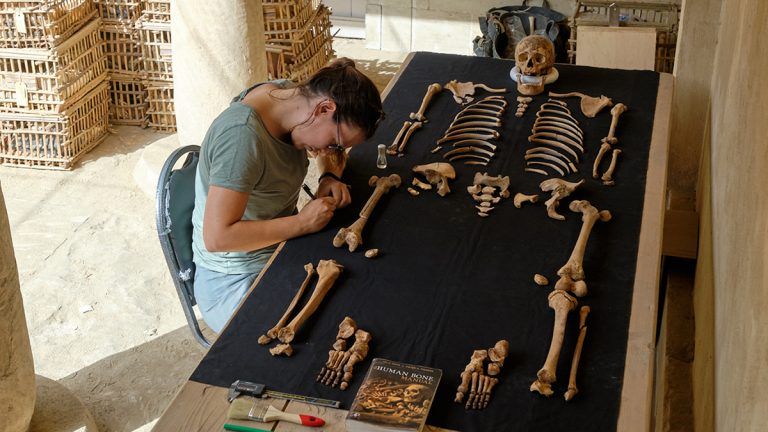
Week 5: carefully labelling each bone.
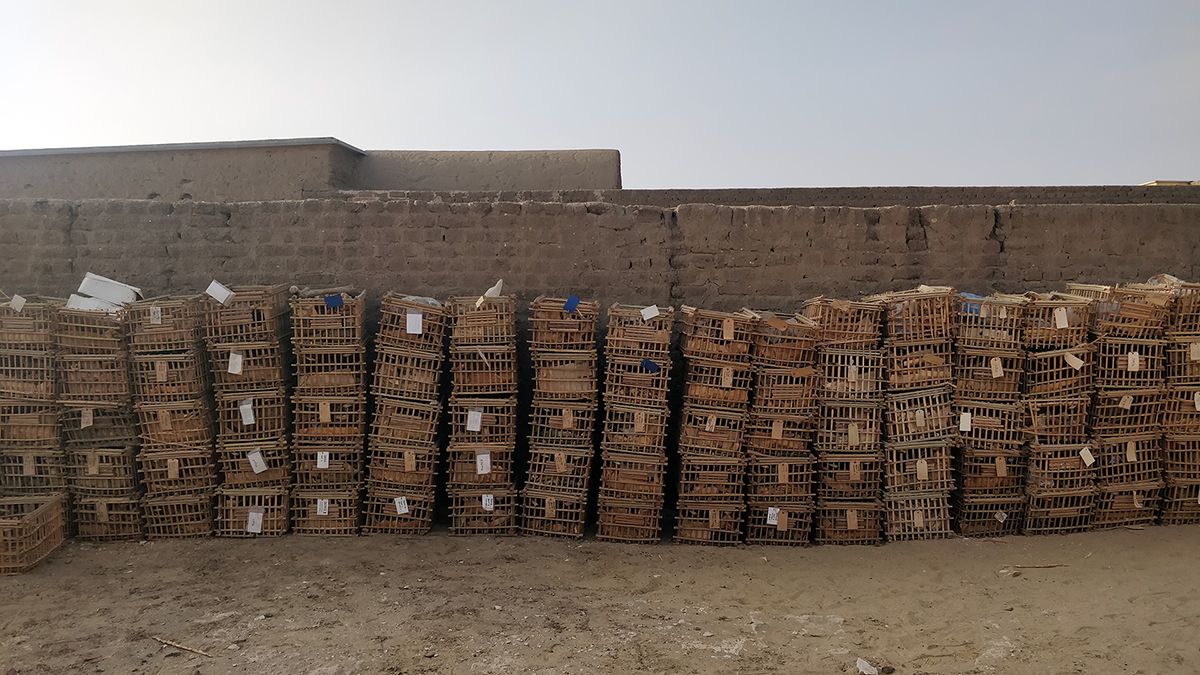
Week 5: 45 years of excavation yield a lot of material.
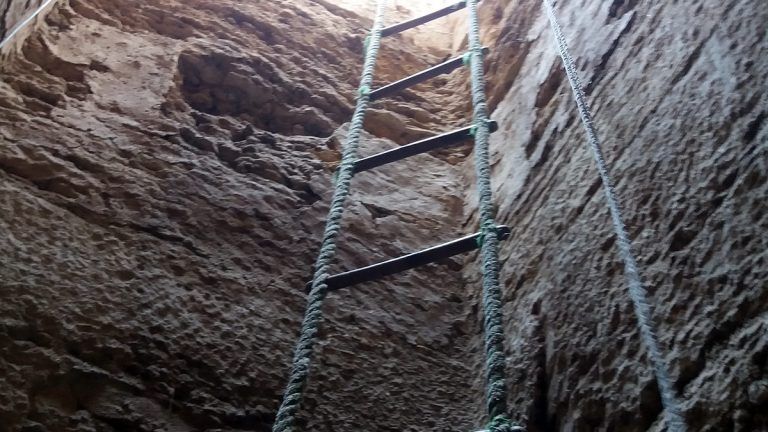
Week 4: rope ladder down into the shaft of Meryneith.
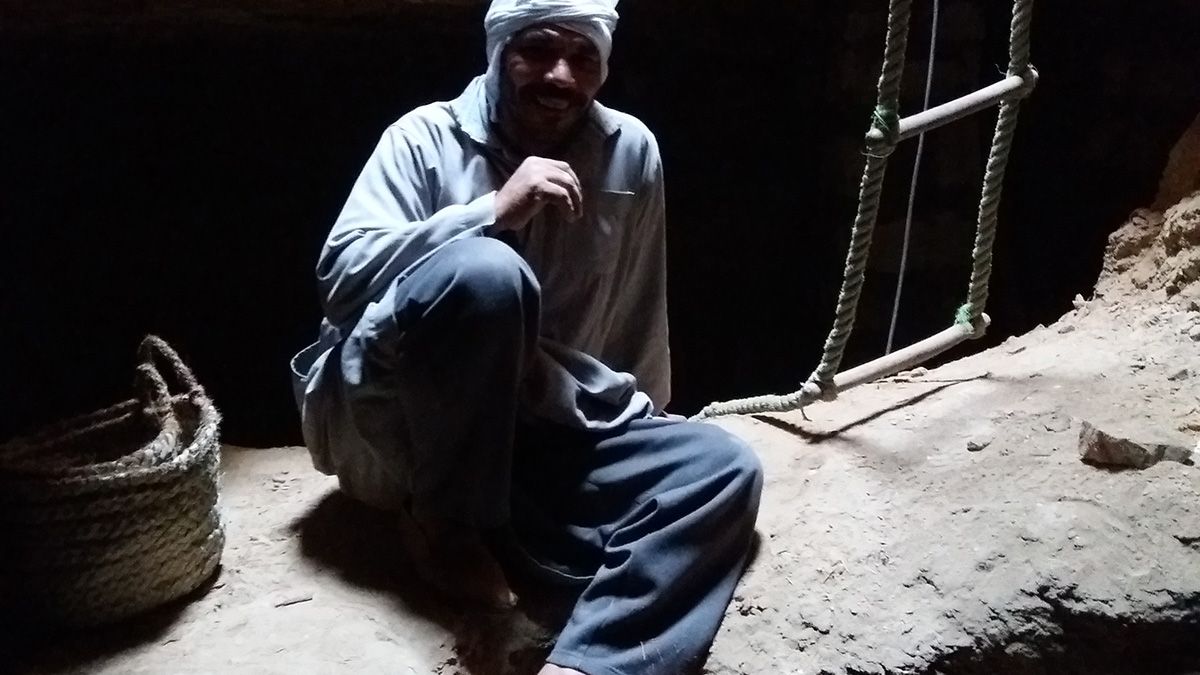
Week 4: down in the shaft of Meryneith.
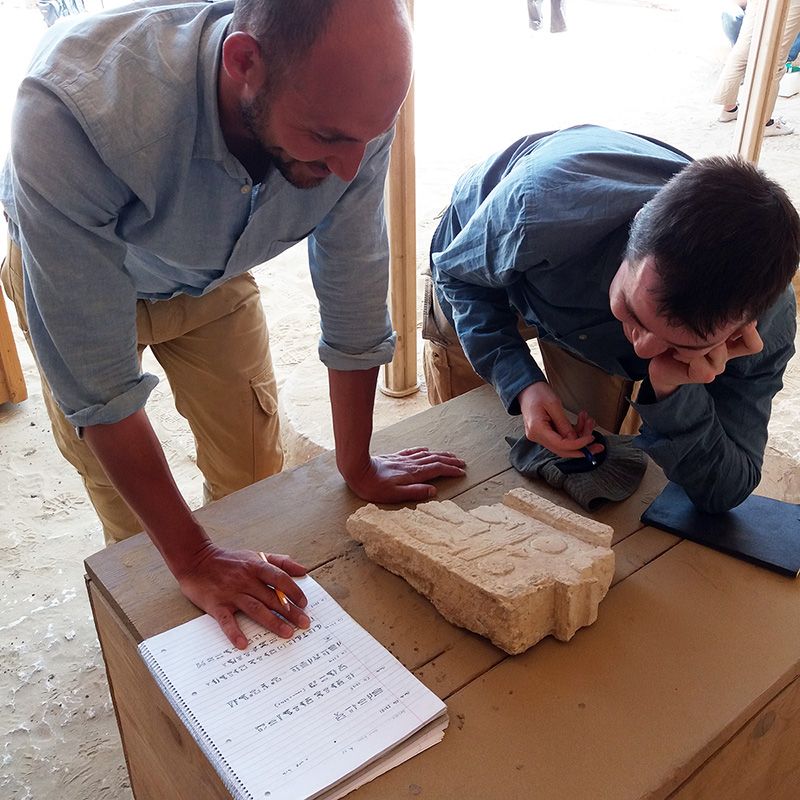
Week 4: team members Daniel Soliman (l) and Huw Twiston Davies (r) are investigating a find.